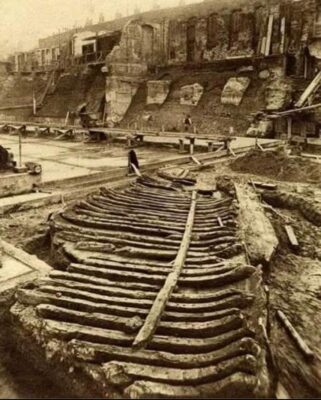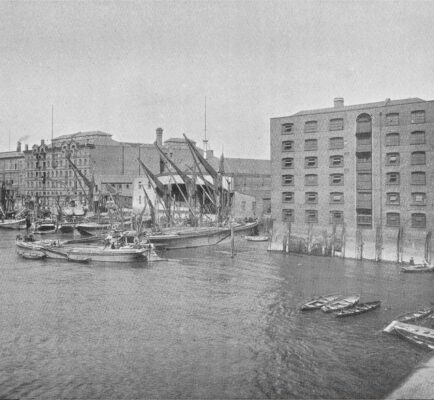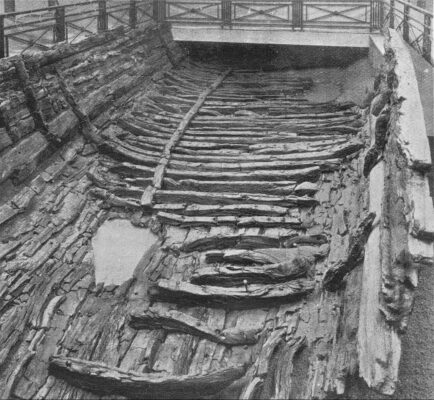The discovery of a 3rd-century Roman ship during the construction of County Hall in 1910 unveiled a fascinating chapter in London’s ancient history. This relic, buried in the Thames’s silt, offers a tangible connection to Londinium, the Roman colony that once thrived on the banks of the river.
The Unearthing of a Roman Relic
The ship’s discovery during the construction of County Hall sparked intrigue and speculation about its origins and purpose.
Accidental Discovery
The ship’s unearthing was an unexpected find, revealing a hidden piece of London’s Roman past.

- Construction Site Find:
- The discovery occurred during the excavation for County Hall’s foundations, highlighting the rich archaeological potential of London’s soil.
- It was a surprise find.
- Buried in Silt:
- The ship’s preservation was attributed to its burial in the Thames’s silt, which protected it from decay.
- The silt preserved it.
- 3rd-Century Relic:
- The ship’s construction, dating back to the 3rd century, aligns with Londinium’s period as a thriving Roman colony.
- It is a relic of Roman London.
Theories and Speculations
The ship’s purpose sparked various theories, with a romantic notion linking it to a historical battle.

- Warship Theory:
- A popular theory suggested the vessel was a warship sunk during the battle between Allectus and Constantius in 296 AD.
- This was a romantic theory.
- Ferryboat Possibility:
- However, it is more likely the ship served as a ferryboat, transporting goods and people across the Thames.
- This is a more likely theory.
- Historical Context:
- These speculations highlight the importance of the Thames as a vital waterway in Roman London.
- The river was important.
Salvage and Initial Display
The ship’s removal and initial display showcased the ingenuity of the time and the public’s fascination with history.

- Giant Wooden Crane:
- The ship was removed from the riverbed in one piece using a giant wooden crane, a testament to early 20th-century engineering.
- It was an impressive feat.
- London Museum Acquisition:
- The London Museum acquired the wreck, recognizing its historical value and displaying it for public viewing.
- The museum preserved it.
- Public Fascination:
- The ship’s display captivated the public, offering a tangible link to London’s Roman past.
- People were interested.
The Ship’s Legacy and Current Status
The ship’s journey from the Thames’s silt to its current storage and dispersed timbers reflects the challenges of preserving historical artifacts.
Museum of London Storage
The ship’s remains are now stored at the Museum of London, continuing its preservation and study.

- Successor Ownership:
- The Museum of London, as the successor to the London Museum, maintains ownership of the ship’s remains.
- The museum is its owner.
- Storage and Preservation:
- The ship is now in storage, ensuring its preservation for future research and potential display.
- It is being kept safe.
- Research Potential:
- The remains offer valuable opportunities for researchers to study Roman shipbuilding techniques and maritime history.
- It is a research resource.
Dispersed Timbers
Some of the ship’s timbers are preserved at the Shipwreck Heritage Centre in Hastings, highlighting the challenges of maintaining complete artifacts.

- Shipwreck Heritage Centre:
- Some timbers are now preserved at the Shipwreck Heritage Centre, adding to the understanding of the ship’s construction.
- Parts of it are in Hastings.
- Partial Survival:
- The ship did not survive intact, with its timbers dispersed across different locations.
- It is not all in one place.
- Historical Fragmentation:
- This fragmentation reflects the challenges of preserving large historical artifacts over time.
- Time has taken its toll.
Historical Significance
The Roman ship’s discovery and preservation contribute to our understanding of Roman London and its maritime activities.
- Londinium’s Maritime History:
- The ship provides insights into Londinium’s maritime history, highlighting the importance of the Thames in the city’s development.
- The river was key to the city.
- Roman Shipbuilding:
- The ship’s construction offers valuable information about Roman shipbuilding techniques and materials.
- We can learn from it.
- Archaeological Value:
- The discovery underscores the archaeological value of London’s historical sites, revealing hidden layers of the city’s past.
- It is an important archaeological find.
The Roman ship discovered beneath County Hall serves as a compelling reminder of London’s ancient roots and the enduring legacy of Londinium. Its journey from the Thames’s silt to museum storage and dispersed timbers highlights the challenges and importance of preserving historical artifacts, offering a tangible connection to a bygone era.

CÁC TIN KHÁC
Mary Walton: The Forgotten Inventor Who Helped Clean Up America’s Cities
Tomb of Queen Nefertari in the Valley of the Queens, Egypt
Discover the Hypostyle Hall of the Temple of Hathor at Dendera
Venus de Losange: Unveiling the Mystery of a 20,000-Year-Old Paleolithic Icon